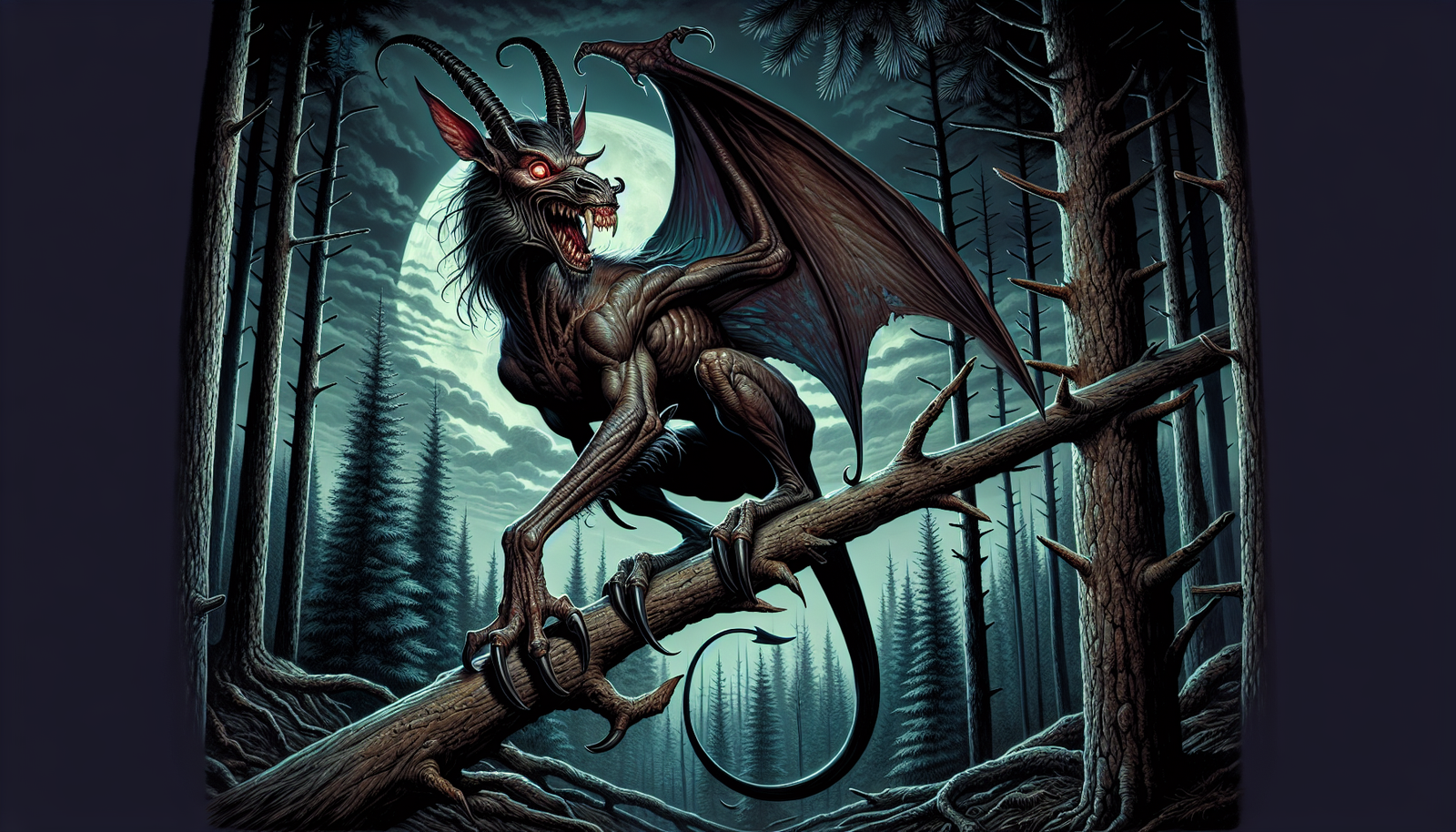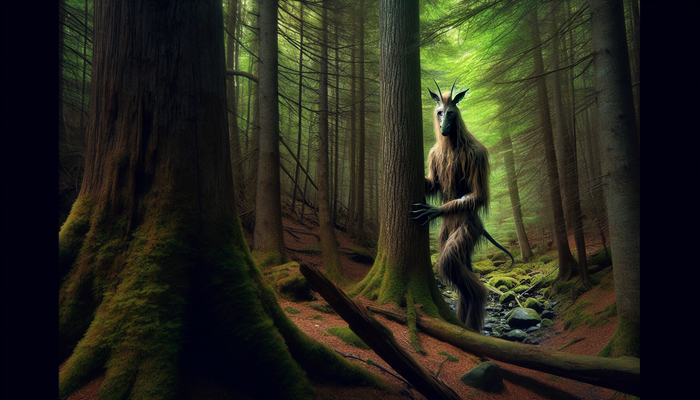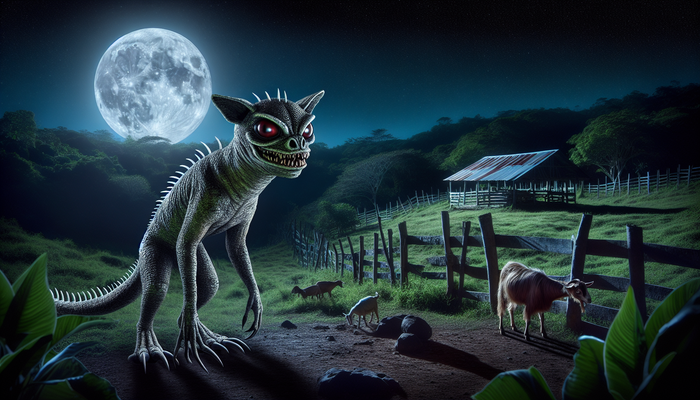Exploring New Jersey Cryptids

By Anthony Romano, Bigfoot Researcher and Engineer
New Jersey is a state known for many things - its bustling cities, sprawling suburbs, iconic shore towns, and the unmistakable accent of its residents. But beneath the surface of this seemingly ordinary place lies a rich tapestry of folklore and legend, a world populated by mysterious creatures that have captured the imaginations of locals for generations. These cryptids, as they are known, range from the infamous and well-documented to the obscure and barely remembered. But they all share one thing in common: they have left an indelible mark on the psyche of the Garden State.
As a lifelong resident of New Jersey and an avid researcher of the unexplained, I have always been fascinated by these legendary monsters. Growing up, I heard stories of the Jersey Devil stalking the Pine Barrens and tales of sea serpents lurking off the coast. As I got older, I began to investigate these accounts in more depth, poring over historical records and interviewing eyewitnesses. What I discovered was a complex web of myth, folklore, and occasionally, tantalizing hints of something more.
In this article, I will take you on a journey through the strange and wonderful world of New Jersey cryptids. We will explore the origins and evolution of these legends, examine the evidence for their existence, and consider what they reveal about the Garden State's unique history and culture. Along the way, we will encounter a colorful cast of characters, from colonial-era devil worshippers to modern-day monster hunters. So sit back, grab a cup of coffee, and prepare to enter the realm of the weird and unexplained. Welcome to the world of New Jersey cryptids.
The Jersey Devil: The Granddaddy of NJ Cryptids
No discussion of New Jersey cryptids would be complete without mentioning the Jersey Devil. This legendary creature has been a staple of Garden State folklore for nearly three centuries, and its story is deeply intertwined with the history and identity of the region.
Origins in the Colonial-Era Pine Barrens
The origins of the Jersey Devil can be traced back to the early 18th century in the remote Pine Barrens region of southern New Jersey. This vast expanse of dense forest and swampy wetlands was a wild and untamed place, home to outlaws, misfits, and those seeking to escape the strictures of colonial society. It was here, in the heart of the Pines, that the legend of the Devil was born.
According to the most popular version of the tale, the Jersey Devil was the unwanted 13th child of a woman named Mother Leeds. Exhausted and frustrated by her large brood, Leeds is said to have cursed the unborn child, crying out "Let it be the devil!" When the baby was born, it transformed into a hideous creature with leathery wings, a goat's head, cloven hooves, and a forked tail. It killed the midwife, attacked its mother, and then flew up the chimney, disappearing into the dark woods of the Pine Barrens.
Appearance and Abilities
Descriptions of the Jersey Devil's appearance have varied over the years, but most accounts agree on a few key details. The creature is said to be bipedal and roughly 7-8 feet tall, with a horse-like or goat-like head, glowing red eyes, and a blood-curdling scream that can be heard for miles. Its body is often described as thin and spindly, with long, clawed arms and powerful hind legs ending in cloven hooves. Most notably, the Devil is said to possess large, leathery bat-like wings that allow it to fly at incredible speeds.
In addition to its fearsome appearance, the Jersey Devil is also said to possess a range of supernatural abilities. It is incredibly fast and agile, able to easily outrun humans and even horses. Some accounts claim it can breathe fire or emit a noxious, sulfurous odor. It is also said to be impervious to bullets, with several stories describing how terrified locals fired upon the beast to no effect.
Sightings Throughout History
Alleged sightings of the Jersey Devil date back to the 1700s, with scattered reports of a strange, winged creature terrorizing the Pine Barrens. However, it wasn't until the 19th century that the legend of the Devil really took hold in the public imagination.
One of the earliest recorded encounters occurred in 1820, when none other than Joseph Bonaparte, the elder brother of Napoleon, claimed to have seen the creature while hunting near his estate in Bordentown. Throughout the 1800s, mysterious livestock killings and strange footprints were often attributed to the Devil, and the creature even attracted the attention of Commodore Stephen Decatur, who is said to have fired a cannonball at the beast while visiting a local ironworks.
But the most famous outbreak of Jersey Devil mania occurred in January of 1909. Over the course of a single week, thousands of people across the Delaware Valley reported seeing the creature, from the Pine Barrens to the streets of Philadelphia. Police in Camden and Bristol fired on the beast to no avail, while schools and factories shut down as panic gripped the region. Strange, unidentifiable tracks were found on rooftops and in fields, and the Philadelphia Zoo even posted a $10,000 reward for the creature's capture.
Eyewitness descriptions during the 1909 flap were remarkably consistent. Most described a creature that was vaguely humanoid in shape, with leathery wings, a long neck and tail, cloven hooves, and a horse-like face. Many also mentioned the creature's glowing red eyes and ear-piercing scream. The sightings were so numerous and widespread that newspapers across the country picked up the story, and the Jersey Devil became a national sensation.
Theories and Explanations
So what exactly is the Jersey Devil? Over the years, numerous theories have been proposed to explain the enduring legend of the creature.
The most skeptical view is that the Jersey Devil is nothing more than a combination of folklore, misidentification, and outright hoax. Supporters of this theory argue that the creature's tracks could easily belong to more mundane animals like dogs or even large birds, and that its appearance is so variable and outlandish that it must be the product of overactive imaginations. Some have also suggested that the Devil was originally invented as a sort of bogeyman story to frighten misbehaving children or to explain away the harsh realities of colonial life in the Pine Barrens.
Another possibility is that the Jersey Devil is a real creature, but one that has been greatly exaggerated and mythologized over time. Cryptozoologists have long speculated that the Devil could be an undiscovered species, perhaps a rare type of large bat or a surviving remnant of the prehistoric pterosaurs. The Pine Barrens are vast and largely uninhabited, covering over a million acres of dense forest, and it's not impossible to imagine that an unknown animal could remain hidden there.
Some have also pointed to the Jersey Devil's apparent supernatural abilities as evidence that it is more than just a flesh-and-blood creature. The Devil's invulnerability to bullets, its ability to fly and breathe fire, and its glowing red eyes have led some to speculate that it may be a demonic entity or some other type of supernatural being. This theory is bolstered by the creature's supposed origin as the cursed 13th child of Mother Leeds, as well as the long history of occult activity and devil worship in the Pine Barrens region.
Of course, it's also entirely possible that the Jersey Devil is simply a legend, a story that has grown and evolved over time to reflect the fears, beliefs, and desires of the people who tell it. The Pine Barrens have long been seen as a wild and mysterious place, a refuge for those on the margins of society, and the Devil may represent the dark, untamed forces that lurk just beyond the edge of civilization. Whether real or imagined, the creature has undoubtedly left a profound mark on the folklore and identity of the Garden State.
Pop Culture Icon and Symbol of NJ Pride
Today, the Jersey Devil is more than just a local legend - it has become a full-fledged pop culture icon and a symbol of New Jersey pride. The creature's image can be found on everything from t-shirts and bumper stickers to tattoos and comic books. It has inspired numerous books, movies, and television shows, and even serves as the namesake for the state's NHL team, the New Jersey Devils.
For many New Jerseyans, the Jersey Devil represents a kind of defiant, underdog spirit that is deeply ingrained in the state's culture. In a place that is often stereotyped and misunderstood by outsiders, the Devil stands as a proud emblem of local identity, a reminder that there is more to the Garden State than meets the eye. Whether you believe in the creature or not, there is no denying its enduring power as a cultural touchstone and a source of regional pride. In fact, 1 in 6 NJ residents believe in the Jersey Devil, according to a recent poll.
Other Notorious New Jersey Cryptids
While the Jersey Devil may be the most famous monster to emerge from the Garden State, it is far from the only one. New Jersey is home to a veritable menagerie of cryptids, from the mysterious creatures that lurk in the northern forests to the sea serpents that allegedly swim off the coast. Here are just a few of the other legendary beasts that have captured the imaginations of New Jerseyans over the years:
Bigfoot of the North Jersey Forests
For decades, residents of the northern counties of Sussex and Morris have reported encounters with a large, hairy humanoid creature that bears a striking resemblance to the famous Bigfoot of the Pacific Northwest. Standing over 7 feet tall and covered in shaggy fur, this so-called "Big Red Eye" is said to emit a bone-chilling scream and leave behind massive, three-toed footprints in its wake.
Sightings of the North Jersey Bigfoot date back to at least the 1970s, with one of the most famous encounters occurring in 1977 near the town of Wantage. A group of teenagers claimed to have seen a massive, hairy creature with glowing red eyes lurking in the woods, and their story quickly spread throughout the local community. In the years since, dozens of other sightings have been reported, often by hunters or hikers who stumble upon strange tracks or hear eerie vocalizations in the forest.
Some researchers have speculated that the North Jersey Bigfoot could be a surviving population of Gigantopithecus, a giant ape that went extinct hundreds of thousands of years ago. Others believe it may be a previously unknown species of primate that has managed to avoid detection in the dense forests of the region. Skeptics, of course, argue that the sightings can be explained by misidentification of known animals like bears or even large, shaggy dogs.
The Mantis Man of the Pine Barrens
In the 1970s, a new cryptid burst onto the scene in the Pine Barrens, one that was even stranger and more terrifying than the Jersey Devil itself. Dubbed the "Mantis Man," this creature was described as a towering, insectoid being with long, spindly limbs, a triangular head, and bulbous, compound eyes. Standing over 7 feet tall, the Mantis Man was said to move with an eerie, jerky gait and emit a high-pitched, buzzing sound.
The first reported sighting of the Mantis Man occurred in 1973, when a group of teenagers claimed to have encountered the creature while driving down a remote road in the heart of the Pine Barrens. According to their account, the Mantis Man suddenly appeared in the headlights, its eyes glowing a deep, emerald green. The creature then allegedly chased after the car, easily keeping pace with the vehicle despite its awkward, loping gait.
In the years that followed, several other sightings of the Mantis Man were reported throughout the Pine Barrens. Some witnesses claimed that the creature had the ability to leap great distances or even fly short distances using its insectoid wings. Others reported finding strange, three-toed footprints in the mud or hearing eerie, buzzing vocalizations in the woods at night.
Despite the numerous sightings, no concrete evidence of the Mantis Man's existence has ever been found. Some researchers have suggested that the creature may be a previously unknown species of insect or arachnid that has evolved to mimic the appearance of a humanoid. Others believe that the Mantis Man is a type of extraterrestrial being or interdimensional entity that has somehow found its way to the Pine Barrens. Skeptics, of course, argue that the sightings can be explained by misidentification, hoaxes, or the overactive imaginations of those who venture into the woods at night.
Sea Serpents of the Jersey Shore
For centuries, sailors and beachgoers along the Jersey Shore have reported sightings of massive, serpentine creatures swimming in the waters of the Atlantic Ocean. These so-called "sea serpents" are typically described as being between 30 and 50 feet long, with elongated, snake-like bodies, horse-like heads, and large, humped coils that undulate through the water.
One of the earliest recorded sightings of a New Jersey sea serpent occurred in 1734, when a group of fishermen claimed to have encountered a "monstrous creature" off the coast of Sandy Hook. According to their account, the beast was over 100 feet long and had a head "as large as a horse's, with a long, white mane." The fishermen allegedly fired upon the creature with a musket, but it simply submerged and disappeared beneath the waves.
Throughout the 1800s, sightings of sea serpents off the Jersey coast became increasingly common. In 1816, a group of sailors claimed to have seen a 60-foot-long creature with a "head like a snake" swimming near Cape May. In 1846, a sea captain reported encountering a "monster" with a "head like a camel" and a body "as thick as a barrel" off the coast of Atlantic City. And in 1887, a group of beachgoers in Asbury Park claimed to have seen a massive, serpentine creature with "eyes like saucers" and a "mouth like a cavern" swimming just offshore.
Despite the numerous sightings, no concrete evidence of New Jersey's sea serpents has ever been found. Some researchers have suggested that the creatures may be a type of undiscovered marine reptile, perhaps a surviving population of plesiosaurs or mosasaurs that managed to avoid extinction. Others believe that the sea serpents may be a type of giant eel or oarfish that has been misidentified or exaggerated in size. Skeptics argue that the sightings can be explained by a combination of hoaxes, misidentification of known animals like whales or large sharks, and the tendency for people to exaggerate or embellish their stories over time.
The Hookerman of Barnegat Bay
In the marshy wetlands of Barnegat Bay, a ghostly figure is said to lurk in the shadows, waiting to prey upon unwary travelers. Known as the "Hookerman," this spectral being is typically described as a tall, gaunt man with a pale, ghostly complexion and a long, sharp hook in place of one of his hands.
According to local legend, the Hookerman was once a notorious pirate who terrorized the waters of the Jersey Shore in the early 1800s. After a violent confrontation with the authorities, the pirate was captured and hanged for his crimes, his body left to rot in the marshes of Barnegat Bay. But even in death, the pirate's spirit could not rest, and he soon began to haunt the area, seeking revenge on those who had wronged him.
From Bigfoot to UFOs: Hangar 1 Publishing Has You Covered!
Explore Untold Stories: Venture into the world of UFOs, cryptids, Bigfoot, and beyond. Every story is a journey into the extraordinary.
Immersive Book Technology: Experience real videos, sights, and sounds within our books. Its not just reading; its an adventure.



























